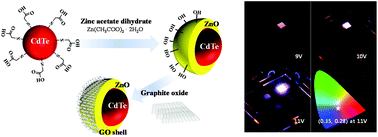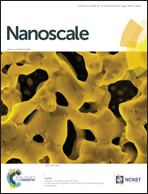Emissive CdTe/ZnO/GO quasi-core–shell–shell hybrid quantum dots for white light emitting diodes†
Abstract
Colloidal quantum dots (QDs) have been extensively studied for optoelectronic and biological applications due to their unique physical and optical properties. In particular, among the optoelectronics applications, the white light emitting diode (WLED) has great potential in flat panel displays and solid-state lighting. Herein, we demonstrate a novel, facile, and efficient technique for the synthesis of CdTe/ZnO/GO quasi-core–shell–shell hybrid quantum dots containing the CdTe core with multi shells of ZnO and graphene oxide (GO) and fabrication of WQDLEDs. The CdTe/ZnO/GO quasi-core–shell–shell QDs have a unique strong photoluminescence (PL) peak at 624 nm related to the CdTe core and new weak peaks at 382, 404, 422, and 440 nm due to conjugation with ZnO and GO. Also, in the electroluminescence (EL), multiple emission peaks are observed, which can be correlated to the recombination process inside the CdTe core and also recombination of electrons in the lowest unoccupied molecular orbital (LUMO) and LUMO+2 of GO and holes in the valence band (VB) of ZnO. The QDLEDs show clear white color emission with a maximum luminance value of about 480 cd m−2 with Commission Internationale de l'Eclairage (CIE) color coordinates of (0.35, 0.28).


 Please wait while we load your content...
Please wait while we load your content...